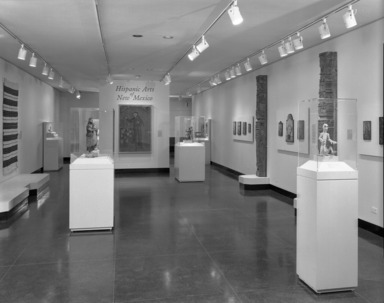

Hispanic Arts of New Mexico, October 20, 1989 through January 22, 1990 (Image: AON_E1989i007.jpg Brooklyn Museum photograph, 1989)

Hispanic Arts of New Mexico, October 20, 1989 through January 22, 1990 (Image: AON_E1989i008.jpg Brooklyn Museum photograph, 1989)

Hispanic Arts of New Mexico, October 20, 1989 through January 22, 1990 (Image: AON_E1989i009.jpg Brooklyn Museum photograph, 1989)

Hispanic Arts of New Mexico, October 20, 1989 through January 22, 1990 (Image: AON_E1989i010.jpg Brooklyn Museum photograph, 1989)
Hispanic Arts of New Mexico
DATES October 20, 1989 through January 22, 1990
ORGANIZING DEPARTMENT
Arts of the Americas
COLLECTIONS
Arts of the Americas
-
October 1, 1989
Hispanic Arts of New Mexico, an exhibition of 29 works mostly created during the 19th century by the Spanish and Indian cultures of New Mexico, will open at The Brooklyn Museum on October 20 and will remain on view in the Lobby Gallery, located on the first floor, through January 22, 1990. The objects in the exhibition, drawn chiefly from the Museum’s own collection, include architectural elements, pottery, painting, sculpture, jewelery and textiles, and illustrate the artistic interaction between Spanish colonists and Native Americans during the period when New Mexico was under Spanish rule.
Geographically and culturally isolated from other Spanish colonies in America, New Mexico posed unique challenges to the Catholic church’s effort to convert the Pueblo, Navajo and Apache Indians of the region. Franciscan friars, who were responsible for the construction and decoration of the churches, employed both Hispanic and Indian artists to make the religious objects needed for the growing number of local churches and new converts. By the early 19th century a distinctive style of religious art had developed. The exhibition includes examples of several of the major image makers of this period including Malleno and José Rafael Aragón.
Most of the paintings (retablos) and sculpture (bultos) in the exhibition were produced for use on home altars, though two carved pilasters come from an early mission church. Secular works on display include textiles and silver work that reflect the Spanish influence on Native American artistic traditions.
This Curator’s Choice exhibition has been organized by Diana Fane, Curator of African, Oceanic, and New World Art, and Sarah Faunce, Curator of European Painting and Sculpture at the Museum.
In conjunction with the exhibition, the Museum’s Department of Public Programs has scheduled gallery talks at 2:00 p.m. for Sundays, October 29, November 12 and December 3, 1989.
Brooklyn Museum Archives. Records of the Department of Public Information. Press releases, 1989 - 1994. 1989, 148-149.
View Original

